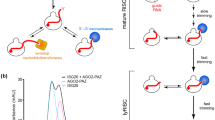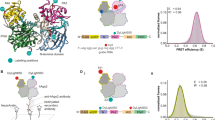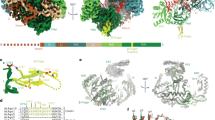Abstract
Argonaute (AGO) proteins bind to small RNAs and mediate small RNA−induced silencing in eukaryotes. Using a minimal in vitro system, we show that bacterially expressed human AGO1 and AGO2 but not AGO3 and AGO4 possess strand-dissociating activity of microRNA (miRNA) duplexes. Both AGO1 and AGO2 function as RNA chaperones, capable of performing multiple rounds of strand dissociation. Unexpectedly, both AGO1 and AGO2 demonstrate passenger strand cleavage activity of a small interfering RNA (siRNA) duplex, but only AGO2 has target RNA cleavage activity. These observations indicate that passenger strand and mRNA endonuclease activities are mechanistically distinct. We further validate these observations in mammalian extracts and cultured mammalian cells, in which we demonstrate that AGO1 uses only miRNA duplexes when assembling translational repression−competent complexes, whereas AGO2 can use both miRNA and siRNA duplexes. We show that passenger strand cleavage and RNA chaperone activities that are intrinsic to both AGO1 and AGO2 are sufficient for RNA-induced silencing complex (RISC) loading.
This is a preview of subscription content, access via your institution
Access options
Subscribe to this journal
Receive 12 print issues and online access
$189.00 per year
only $15.75 per issue
Buy this article
- Purchase on Springer Link
- Instant access to full article PDF
Prices may be subject to local taxes which are calculated during checkout






Similar content being viewed by others
References
Filipowicz, W., Bhattacharyya, S.N. & Sonenberg, N. Mechanisms of post-transcriptional regulation by microRNAs: are the answers in sight? Nat. Rev. Genet. 9, 102–114 (2008).
Hutvagner, G. & Simard, M.J. Argonaute proteins: key players in RNA silencing. Nat. Rev. Mol. Cell Biol. 9, 22–32 (2008).
Song, J.J., Smith, S.K., Hannon, G.J. & Joshua-Tor, L. Crystal structure of Argonaute and its implications for RISC slicer activity. Science 305, 1434–1437 (2004).
Rivas, F.V. et al. Purified Argonaute2 and an siRNA form recombinant human RISC. Nat. Struct. Mol. Biol. 12, 340–349 (2005).
Yuan, Y.R. et al. Crystal structure of A. aeolicus argonaute, a site-specific DNA-guided endoribonuclease, provides insights into RISC-mediated mRNA cleavage. Mol. Cell 19, 405–419 (2005).
Wang, Y. et al. Structure of an argonaute silencing complex with a seed-containing guide DNA and target RNA duplex. Nature 456, 921–926 (2008).
Wang, Y., Sheng, G., Juranek, S., Tuschl, T. & Patel, D.J. Structure of the guide-strand-containing argonaute silencing complex. Nature 456, 209–213 (2008).
Liu, J. et al. Argonaute2 is the catalytic engine of mammalian RNAi. Science 305, 1437–1441 (2004).
Meister, G. et al. Human Argonaute2 mediates RNA cleavage targeted by miRNAs and siRNAs. Mol. Cell 15, 185–197 (2004).
Tolia, N.H. & Joshua-Tor, L. Slicer and the argonautes. Nat. Chem. Biol. 3, 36–43 (2007).
Nykänen, A., Haley, B. & Zamore, P.D. ATP requirements and small interfering RNA structure in the RNA interference pathway. Cell 107, 309–321 (2001).
Schwarz, D.S. et al. Asymmetry in the assembly of the RNAi enzyme complex. Cell 115, 199–208 (2003).
Matranga, C., Tomari, Y., Shin, C., Bartel, D.P. & Zamore, P.D. Passenger-strand cleavage facilitates assembly of siRNA into Ago2-containing RNAi enzyme complexes. Cell 123, 607–620 (2005).
Robb, G.B. & Rana, T.M. RNA helicase A interacts with RISC in human cells and functions in RISC loading. Mol. Cell 26, 523–537 (2007).
Meister, G. et al. Identification of novel argonaute-associated proteins. Curr. Biol. 15, 2149–2155 (2005).
Chu, C.Y. & Rana, T.M. Translation repression in human cells by microRNA-induced gene silencing requires RCK/p54. PLoS Biol. 4, e210 (2006).
Mourelatos, Z. et al. miRNPs: a novel class of ribonucleoproteins containing numerous microRNAs. Genes Dev. 16, 720–728 (2002).
Leuschner, P.J., Ameres, S.L., Kueng, S. & Martinez, J. Cleavage of the siRNA passenger strand during RISC assembly in human cells. EMBO Rep. 7, 314–320 (2006).
Rand, T.A., Petersen, S., Du, F. & Wang, X. Argonaute2 cleaves the anti-guide strand of siRNA during RISC activation. Cell 123, 621–629 (2005).
Gregory, R.I., Chendrimada, T.P., Cooch, N. & Shiekhattar, R. Human RISC couples microRNA biogenesis and posttranscriptional gene silencing. Cell 123, 631–640 (2005).
Maniataki, E. & Mourelatos, Z. A human, ATP-independent, RISC assembly machine fueled by pre-miRNA. Genes Dev. 19, 2979–2990 (2005).
Miyoshi, K., Uejima, H., Nagami-Okada, T., Siomi, H. & Siomi, M.C. In vitro RNA cleavage assay for Argonaute-family proteins. Methods Mol. Biol. 442, 29–43 (2008).
Doench, J.G., Petersen, C.P. & Sharp, P.A. siRNAs can function as miRNAs. Genes Dev. 17, 438–442 (2003).
Doench, J.G. & Sharp, P.A. Specificity of microRNA target selection in translational repression. Genes Dev. 18, 504–511 (2004).
Martinez, J., Patkaniowska, A., Urlaub, H., Luhrmann, R. & Tuschl, T. Single-stranded antisense siRNAs guide target RNA cleavage in RNAi. Cell 110, 563–574 (2002).
Haley, B. & Zamore, P.D. Kinetic analysis of the RNAi enzyme complex. Nat. Struct. Mol. Biol. 11, 599–606 (2004).
Wang, B., Love, T.M., Call, M.E., Doench, J.G. & Novina, C.D. Recapitulation of short RNA-directed translational gene silencing in vitro. Mol. Cell 22, 553–560 (2006).
Wang, B., Yanez, A. & Novina, C.D. MicroRNA-repressed mRNAs contain 40S, but not 60S components. Proc. Natl. Acad. Sci. USA 105, 5343–5348 (2008).
Griffiths-Jones, S. The MicroRNA Registry. Nucleic Acids Res. 32, D109–D111 (2004).
Zeng, Y. Regulation of the mammalian nervous system by microRNAs. Mol. Pharmacol. 75, 259–264 (2009).
Qi, H.H. et al. Prolyl 4-hydroxylation regulates Argonaute 2 stability. Nature 455, 421–424 (2008).
Beitzinger, M., Peters, L., Zhu, J.Y., Kremmer, E. & Meister, G. Identification of human microRNA targets from isolated argonaute protein complexes. RNA Biol. 4, 76–84 (2007).
Easow, G., Teleman, A.A. & Cohen, S.M. Isolation of microRNA targets by miRNP immunopurification. RNA 13, 1198–1204 (2007).
Landthaler, M. et al. Molecular characterization of human Argonaute-containing ribonucleoprotein complexes and their bound target mRNAs. RNA 14, 2580–2596 (2008).
Hendrickson, D.G., Hogan, D.J., Herschlag, D., Ferrell, J.E. & Brown, P.O. Systematic identification of mRNAs recruited to argonaute 2 by specific microRNAs and corresponding changes in transcript abundance. PLoS One 3, e2126 (2008).
Lewis, B.P., Burge, C.B. & Bartel, D.P. Conserved seed pairing, often flanked by adenosines, indicates that thousands of human genes are microRNA targets. Cell 120, 15–20 (2005).
Asangani, I.A. et al. MicroRNA-21 (miR-21) post-transcriptionally downregulates tumor suppressor Pdcd4 and stimulates invasion, intravasation and metastasis in colorectal cancer. Oncogene 27, 2128–2136 (2008).
Frankel, L.B. et al. Programmed cell death 4 (PDCD4) is an important functional target of the microRNA miR-21 in breast cancer cells. J. Biol. Chem. 283, 1026–1033 (2008).
Lu, Z. et al. MicroRNA-21 promotes cell transformation by targeting the programmed cell death 4 gene. Oncogene 27, 4373–4379 (2008).
Zhu, S. et al. MicroRNA-21 targets tumor suppressor genes in invasion and metastasis. Cell Res. 18, 350–359 (2008).
Nelson, P.T., Hatzigeorgiou, A.G. & Mourelatos, Z. miRNP:mRNA association in polyribosomes in a human neuronal cell line. RNA 10, 387–394 (2004).
Höck, J. et al. Proteomic and functional analysis of Argonaute-containing mRNA-protein complexes in human cells. EMBO Rep. 8, 1052–1060 (2007).
Förstemann, K., Horwich, M.D., Wee, L., Tomari, Y. & Zamore, P.D. Drosophila microRNAs are sorted into functionally distinct Argonaute complexes after production by Dicer-1. Cell 130, 287–297 (2007).
Tomari, Y., Du, T. & Zamore, P.D. Sorting of Drosophila small silencing RNAs. Cell 130, 299–308 (2007).
Rajkowitsch, L. et al. RNA chaperones, RNA annealers and RNA helicases. RNA Biol. 4, 118–130 (2007).
Izzo, A., Regnard, C., Morales, V., Kremmer, E. & Becker, P.B. Structure-function analysis of the RNA helicase maleless. Nucleic Acids Res. 36, 950–962 (2008).
Wang, B., Doench, J.G. & Novina, C.D. Analysis of microRNA effector functions in vitro. Methods 43, 91–104 (2007).
Acknowledgements
We thank M. Janas and J. Doench for insightful recommendations and critical reading of the manuscript. We also thank Y. Pan for assistance with the AGO pull-down assays. We thank E. Gagnon for creating Figure 6. This work was supported by a Distinguished Young Scholars Award from the W.M. Keck Foundation to C.D.N.
Author information
Authors and Affiliations
Contributions
B.W. designed and performed experiments, analyzed data and co-wrote the manuscript; S.L. and H.H.Q. performed experiments; D.C. and Y.S. analyzed data; C.D.N. designed experiments, analyzed data and co-wrote the manuscript.
Corresponding author
Supplementary information
Supplementary Text and Figures
Supplementary Figures 1–8 and Supplementary Discussion (PDF 9647 kb)
Rights and permissions
About this article
Cite this article
Wang, B., Li, S., Qi, H. et al. Distinct passenger strand and mRNA cleavage activities of human Argonaute proteins. Nat Struct Mol Biol 16, 1259–1266 (2009). https://doi.org/10.1038/nsmb.1712
Received:
Accepted:
Published:
Issue Date:
DOI: https://doi.org/10.1038/nsmb.1712
This article is cited by
-
MICROmanagement of Runx2 Function in Skeletal Cells
Current Molecular Biology Reports (2019)
-
Opposing activities of oncogenic MIR17HG and tumor suppressive MIR100HG clusters and their gene targets regulate replicative senescence in human adult stem cells
npj Aging and Mechanisms of Disease (2017)
-
Leishmania (Leishmania) amazonensis induces macrophage miR-294 and miR-721 expression and modulates infection by targeting NOS2 and L-arginine metabolism
Scientific Reports (2017)
-
Structural and functional studies of a noncanonical Dicer from Entamoeba histolytica
Scientific Reports (2017)
-
Revealing a new activity of the human Dicer DUF283 domain in vitro
Scientific Reports (2016)



